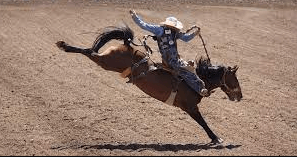What Are The Different Types Of Jumps In Cross-Country Riding?

‘Leap into the world of cross-country riding and explore the exhilarating realm of jumps. As the saying goes, ‘The sky is not the limit, but only a stepping stone.’
Cross-country riding offers riders a thrilling experience that combines equestrian skills with an innate desire for freedom. In this article, we will delve into the different types of jumps that test both horse and rider’s abilities to navigate obstacles with agility and grace.
First on our journey are log jumps, which challenge riders to navigate over solid wooden logs placed horizontally across their path. These jumps require careful planning and precise execution as riders must assess the height and width of each log before deciding on their approach.
Water jumps, on the other hand, provide an aquatic twist to cross-country riding. Riders must guide their horses through bodies of water, such as ponds or streams, while jumping over submerged obstacles like logs or rails. This type of jump demands not only skillful riding but also trust between horse and rider as they conquer these watery challenges together.
Lastly, bank jumps add a vertical element to cross-country riding by incorporating natural or artificial inclines in the terrain. Riders must approach these slopes at varying speeds and angles to successfully ascend or descend them while maintaining control and balance. The thrill lies in conquering these sudden changes in elevation with finesse and precision.
So saddle up and join us as we uncover the diverse world of cross-country jumps – where horsemanship meets adventure! Whether you seek an adrenaline rush or simply wish to embrace your subconscious desire for freedom, understanding these different types of jumps will deepen your appreciation for this exhilarating sport.’
Log Jumps
Log jumps are a common and challenging type of obstacle in cross-country riding, requiring riders to navigate over stacked logs that test their skill and precision, igniting a sense of exhilaration and accomplishment.
Log jump techniques vary depending on the height and width of the logs, but generally involve maintaining a balanced position with eyes focused ahead, allowing the horse to take off at the appropriate distance from the jump.
Riders should also use their legs to encourage impulsion and lift over the logs, while keeping a light contact on the reins for control and guidance.
Safety precautions when log jumping include ensuring that both horse and rider are adequately prepared by practicing over smaller obstacles before attempting larger ones. It is also important to inspect the log jump for any potential hazards such as loose branches or uneven terrain.
Wearing appropriate safety gear, such as helmets and protective vests, is essential in case of falls or accidents.
By following proper log jump techniques and safety precautions, riders can enjoy this thrilling aspect of cross-country riding while minimizing risks.
Water Jumps
Aqua obstacles are a prominent feature in the equestrian discipline of cross-country, requiring riders to navigate through water jumps.
When approaching water jumps, riders need to maintain balance and control over their horses while ensuring a smooth transition between different terrains.
Common mistakes while navigating water jumps include misjudging the depth or width of the jump, resulting in hesitation or refusal from the horse.
Additionally, riders may struggle with maintaining an appropriate pace throughout the jump or failing to properly position themselves for a successful landing.
It is crucial for riders to have good communication and trust with their horses as they approach and navigate water jumps in order to achieve success in this challenging aspect of cross-country riding.
Bank Jumps
Bank jumps, also known as slope obstacles, require riders to navigate steep inclines and declines while maintaining balance and control over their horses. These jumps can be a challenging but valuable addition to training routines for cross-country riding.
Read also: What Are The Different Phases In Combined Driving?
Incorporating bank jumps in training allows riders to develop key skills such as adjusting the horse’s stride length, improving overall coordination, and enhancing the horse’s ability to maintain balance on uneven terrain.
Bank jumps also help build trust between horse and rider, as it requires effective communication and cooperation to successfully navigate these obstacles.
By practicing bank jump techniques, riders can improve their ability to assess the terrain ahead and make quick decisions regarding stride adjustments and weight distribution.
This type of training not only enhances a rider’s technical abilities but also contributes to the overall physical fitness of both horse and rider.
The incorporation of bank jumps in cross-country riding provides an exciting challenge that promotes skill development while further deepening the bond between horse and rider.
Frequently Asked Questions
How do I know if my horse is ready to attempt more challenging cross-country jumps?
To determine whether your horse is ready for more challenging cross-country jumps, assess both its physical readiness and mental preparedness. Observe its fitness level, soundness, and agility, while also considering its confidence, willingness to approach obstacles, and ability to maintain focus.
What kind of safety precautions should be taken when approaching water jumps?
Water jump safety is crucial in cross-country riding. Common mistakes include approaching too fast or hesitating, leading to accidents. Riders should maintain a steady pace, use proper leg aids, and keep their eyes up for a successful water jump approach.
Are there any specific training exercises I can do to improve my horse’s technique over bank jumps?
Training exercises can greatly improve a horse’s technique over bank jumps. One effective exercise is setting up a small, gradual slope for the horse to practice going up and down. This helps develop balance, strength, and confidence in approaching bank jumps.
What are the common mistakes riders make when approaching log jumps and how can I avoid them?
Common mistakes riders make when approaching log jumps include lack of balance, improper pace, and failure to look ahead. To avoid these errors, riders should maintain a secure position, establish the correct speed, and focus on their line of approach. Additionally, incorporating tips for improving technique over bank jumps can enhance overall performance.
How can I prepare myself mentally and physically for the demands of cross-country riding?
To prepare oneself mentally for the demands of cross-country riding, it is important to develop mental toughness and focus through visualization techniques and positive self-talk. Physical conditioning should include cardiovascular exercises, strength training, and flexibility exercises to enhance endurance, balance, and coordination.
Conclusion
Cross-country riding involves various types of jumps that riders must navigate through.
Log jumps are one type, which require the horse and rider to jump over a log obstacle. These can vary in size and difficulty, with some logs being low and others being higher and more challenging.
Another type of jump is the water jump, where horses are required to jump over a pool or body of water. This requires both skill and confidence from the horse and rider, as they need to accurately judge the distance and take-off point in order to clear the water safely.
Bank jumps are also common in cross-country riding. These involve jumping up or down a slope or bank, requiring horses to have good balance and strength. Riders must carefully approach these jumps at the correct speed in order to successfully navigate them.
In conclusion, cross-country riding offers a variety of jumps for riders to tackle. From log jumps to water jumps and bank jumps, each type requires different skills from both horse and rider. It’s important for riders to train their horses properly in order to successfully navigate these obstacles on the course. As they say, ‘practice makes perfect,’ so consistent training is essential for achieving success in cross-country riding.



